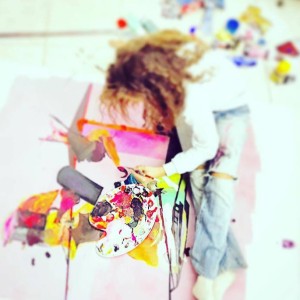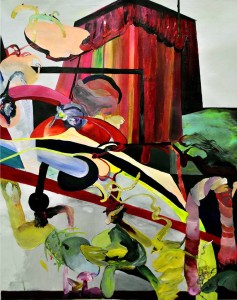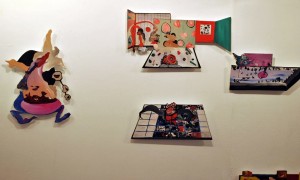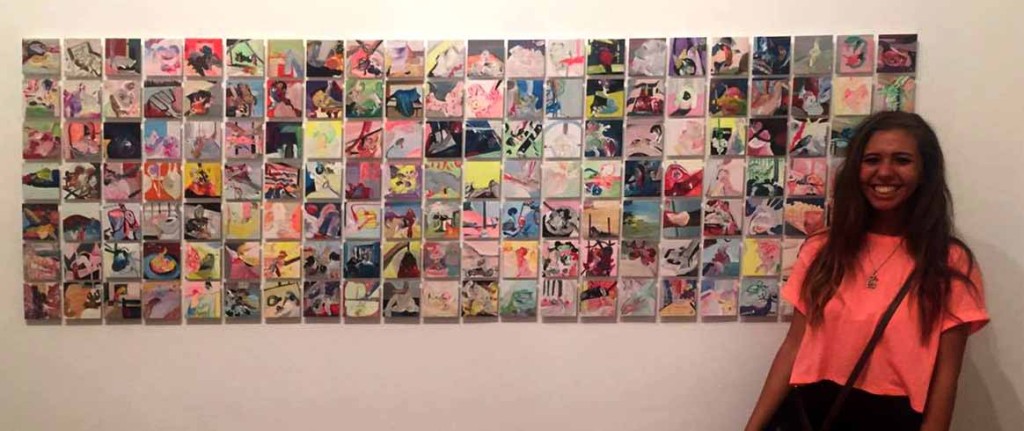
Have you ever stopped and asked yourself what art really is? Most of the time, art is perceived as something beautiful, a pretty picture, a portrait that looks so real or a breathtaking landscape, but what is art really? And is it fair to only classify those eye-friendly pieces as art?
A young talented Egyptian artist, Nada Baraka, tackles art from a completely different perspective. And though her work is widely misunderstood and misinterpreted, only those who really appreciate real forms of art will appreciate her brush strokes of acrylic paint on canvas that make an incredible statement. Baraka’s work tackles issues such as gender, identity and the constant inner struggles our bodies face.
 Ever since she was young, Baraka was interested in biology and was fascinated with the human body. As she got older, her artwork started to show this fascination, as her work revolves around the different organs and portrays the inner struggle and constant explosions that happen within our systems. Baraka protests against the use of the human body as a seductive tool or the constant transformations and manipulation our bodies undergo in her artwork, while other times her work shows the inner struggle of what she feels is happening in her body or in a body that is suffering, screaming, wanting to explode.
Ever since she was young, Baraka was interested in biology and was fascinated with the human body. As she got older, her artwork started to show this fascination, as her work revolves around the different organs and portrays the inner struggle and constant explosions that happen within our systems. Baraka protests against the use of the human body as a seductive tool or the constant transformations and manipulation our bodies undergo in her artwork, while other times her work shows the inner struggle of what she feels is happening in her body or in a body that is suffering, screaming, wanting to explode.
Upon seeing Baraka’s artwork for the first time, it makes you stop and think; your brain will be rattled, trying to make sense and understand what the painting is all about. In Egypt, most people are unfamiliar with the style of art Baraka is undertaking. Her artwork, classified under abstract figurative art, depicts a concept she has been working on for a few years now.
“The body is a living, floating space that changes as it is constantly affected by our actions, therefore altering its wholeness. The body is understood as a battlefield of gender representation and loaded with deep and complex socio-political values. The subject/object of a ‘never ending and always becoming’ process is configured as a map of reality: indeed, everything happens on the skin, causing tension and fusion internally and externally,” Baraka explained.
 The evolution of art throughout different movements show that art isn’t just about painting, but about having a concept that is well researched and expressed in a unique style. Baraka’s statement is a strong one and is constantly developing with her ongoing research and search for new inspirations.
The evolution of art throughout different movements show that art isn’t just about painting, but about having a concept that is well researched and expressed in a unique style. Baraka’s statement is a strong one and is constantly developing with her ongoing research and search for new inspirations.
“My paintings have different shades of skin tones and hues of red as it is constantly trying to show an emotion or an explosion of a tiresome body that is always on the verge on discharge. The colours are fused together forming new organic shapes and body parts of humans and unidentified creatures. Although they are abstract my choice of colour, helps one to identify it to a body-specifically that of a female-because it consists of pink tones scattered around the painting,” Baraka told us.
Baraka’s love for art grew stronger while studying under one of her greatest mentors, Dr. Shady El Noshokaty at the American University in Cairo, but even though she graduated with a BA in Fine Arts, there was still lots of room for her skills to grow and manifest into those of a professional artist.
One of the problems Baraka has faced was the perception of art as a profession from people in her society. “In Egypt, art isn’t looked upon as a profession. While studying art, people would either ask me if I was planning on becoming an art teacher or whether or not I could draw them, but nobody took me seriously,” she said. This assumption along with her need to learn more skills and knowledge led Baraka to enroll in a Master’s program in Central Saint Martins, University of the Arts in London.
 While studying abroad, Baraka learnt how to be an independent artist, developed her skills and experienced a great deal from the surrounding artists working with her in the studio. “Even though I was an Art Major at AUC, we didn’t have our own studio space on campus. We would just go to classes and then continue drawing at home.” Baraka goes on to explain that working with different artists coming from different backgrounds teaches you different techniques and constantly inspires and motivates you.
While studying abroad, Baraka learnt how to be an independent artist, developed her skills and experienced a great deal from the surrounding artists working with her in the studio. “Even though I was an Art Major at AUC, we didn’t have our own studio space on campus. We would just go to classes and then continue drawing at home.” Baraka goes on to explain that working with different artists coming from different backgrounds teaches you different techniques and constantly inspires and motivates you.
After returning to Egypt, Baraka was sponsored by Mashrabiya Gallery and had her first solo art exhibition, Fractals, in January, 2015. A simple Google search explains that a fractal is a never-ending pattern, or infinite-complex patterns that repeat themselves over and over again. Taking inspiration from science-fiction and Internet images, Baraka morphs them in her paintings to depict how the human body is conceived. With bits and pieces coming together, Baraka repeats the same concept with different techniques that look quite inviting at first, until you realize the struggle and even gruesome scenes within her art.

In January 2016, Baraka took part in Egyptian artist Mohamed Abla‘s art competition alongside 300 other artists and was awarded first prize. “When I won the prize, apart from the fact that it was great, it was an accomplishment in itself to see that the art scene was not only evolving in Egypt, but contemporary art was also being appreciated,” she said. Baraka explains that even though the judges and participants were fascinated by her art, the attendees did not understand her artwork or appreciative the idea of conceptual art.

Baraka’s work was also exhibited at Gypsum Gallery, which is a stepping stone in the beginning of what seems to be an interesting career. “Gypsum Gallery is an internationally recognized art gallery which only takes international artists or others who are very well known, so it was quite exciting when they contacted me,” she explained.
Although being a professional artist in Egypt is not an easy mission, especially with no organizations offering financial support, Baraka is still standing on both feet, striving to make her dream of becoming an international artist come true.
WE SAID THIS: Follow Nada Baraka’s page on Facebook to keep up to date with her great work!


